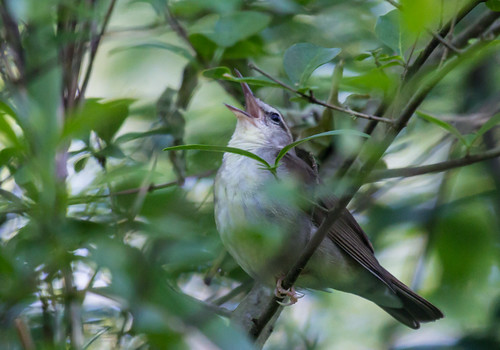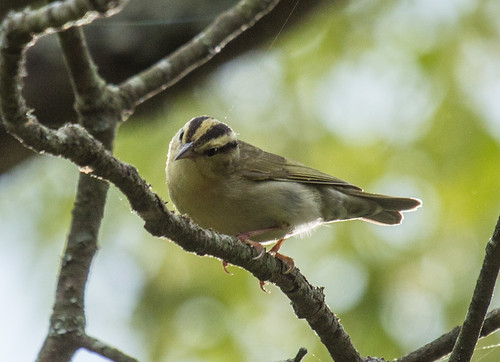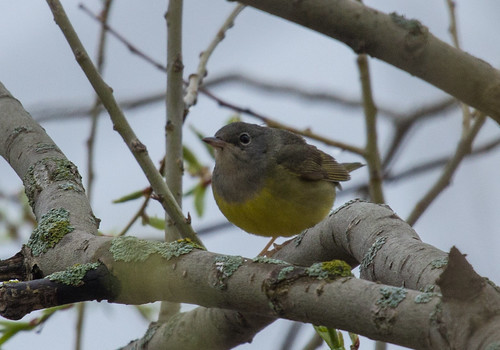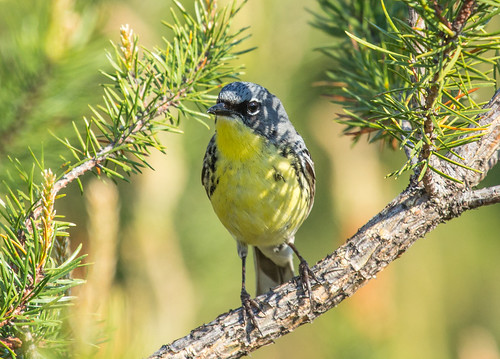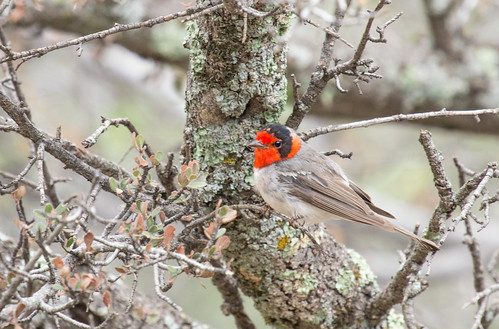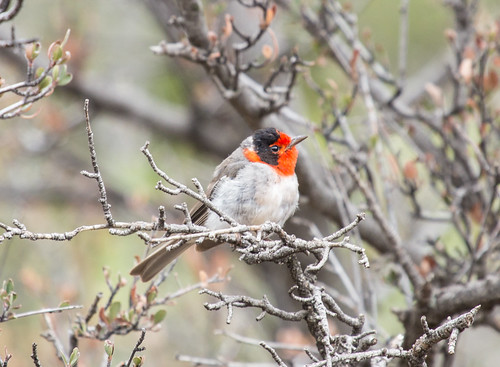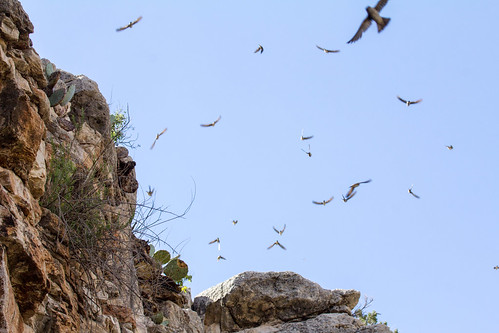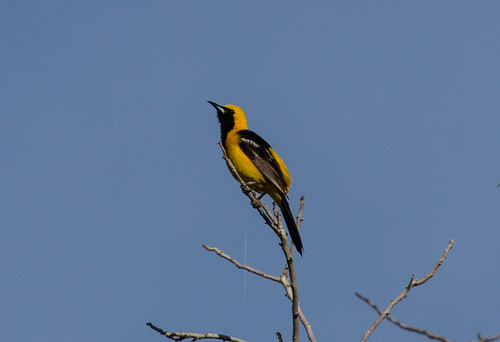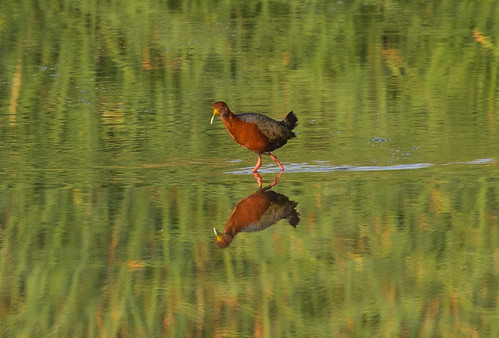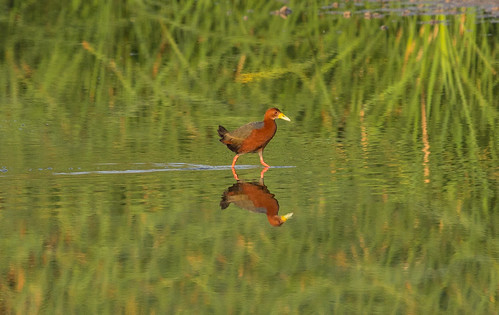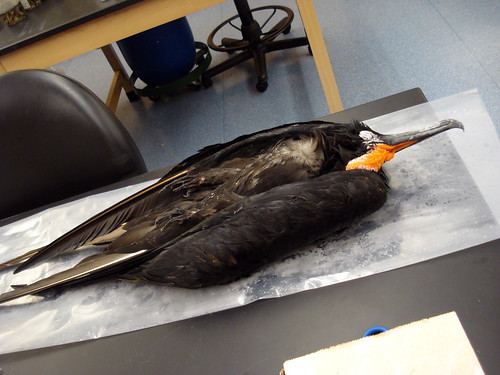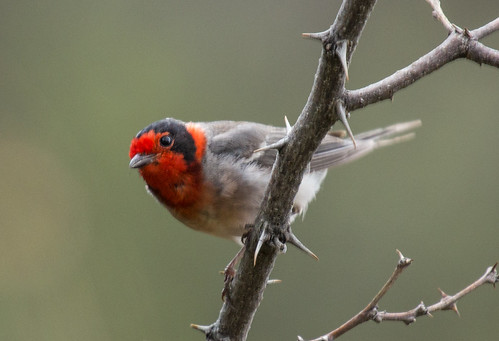When I started birding, my field guides became like old-fashioned Sears Christmas catalogs—personal wish books showing an amazing array of beautiful birds. I longed to see as many species as I could, and when I started paying close attention to the wood warblers, especially the 2-page spread in the Golden Guide showing head shots of just about all of them, I thought I’d never be happy until I’d seen every last one.
I quickly discovered that that was an impossible dream, because at that time in 1975, one of the birds in that array, Bachman’s Warbler, was already extinct. But little by little, bird by bird, I managed to see almost all the others. Not until I was doing some traveling to the tropics did I ever see a Swainson’s or Golden-cheeked Warbler, and I never did see a Colima Warbler, but decades later, the dream of eventually seeing all the still-existing warbler species was still rattling around in my brain.
So naturally, when I started my Conservation Big Year this year, I hoped to see as many warblers as possible. I got wonderful looks, photos, and even sound recordings of a Swainson’s Warbler in southeastern Oklahoma when I was on a field trip during the Red Slough Birding Festival.
In Delaware, I got photos of a couple of Worm-eating Warblers.
During a cold snap in Duluth in late May I saw a Connecticut Warbler at Park Point.
And in early June saw Kirtland’s Warblers in Michigan. Suddenly I realized that I’d already seen every warbler species that nests in the US east of Texas just this year. But I’d still never seen the Colima Warbler (the only regular nesting North American warbler I’d never seen anywhere), which is a fairly common breeder in the Sierra Madre Occidental, a mountain range in western Mexico—it makes it into the United States only in the Chisos Mountains of Big Bend National Park, and there only in stands of oak and pine at certain elevations.
I headed to New Mexico in mid-July in hopes of seeing the Rufous-necked Wood-Rail that had showed up in Bosque del Apache National Wildlife Refuge, and wanted to see as many other southwestern species as I could unearth. After I had great luck with the wood-rail, I took a 4-mile hike on a mountain road in nearby Water Canyon—a wonderful area where I saw Virginia’s, Grace’s, and Red-faced Warblers and a Painted Redstart.
I had such a splendid time that I camped in the Cibola National Forest campground and headed out in the morning on an 8-mile hike, getting twice as far up the mountain and seeing even more beautiful Red-faced Warblers.
You’d think this avian wealth would have been enough to satisfy me, but it merely whetted my drive to get out and find myself a Colima Warbler at long last. So the day after I’d done the long hike in Water Canyon, I headed for Big Bend, taking brief detours at a few interesting spots, such as Smokey Bear Historical Park, where Smokey is buried, and an overlook of the Capitan Valley where Smokey Bear was found as a cub, clinging to a charred tree after being burned in a huge forest fire and rescued by fire fighters.
I ended the day in Carlsbad. I’d gone through the caverns over 30 years ago with Russ and our first baby. It was splendid, but I wasn’t interested in getting into the cave—I merely wanted to stand at the entrance and watch the Cave Swallows.
I spent Sunday morning at the park, first in Rattlesnake Springs, a lovely bit of habitat a few miles away that belongs to the national park, and then at Carlsbad Caverns National Park proper. I picked up several species I’d not seen elsewhere such as Scott’s and Hooded Orioles, finally got nice photos of Black-tailed Gnatcatchers, and got several poor photos of the Cave Swallows. They swooped and darted this way and that, not cooperating in the least with my desire for a perfect photo, but were a new species for my conservation big year list.
At mid-afternoon, I took off for Big Bend. It’s very remote—the nearest city, the tiny town of Marathon, Texas, is 70 miles from park headquarters. I checked into the Chisos Mountains Lodge just before dark, set my alarm for 4 am, and was ready for a nice long hike up the Laguna Meadow Trail to the Colima Trail and down the Boot Canyon and Pinnacle Trails.
It’s expensive to stay in the Chisos Mountains Lodge inside the park, but it’s located right at the trailhead, and so I badly wanted to do the big hike up to the Colima Trail on my one full day in the park. A great many people warned me of the dangers of visiting Big Bend in July, the hottest month of the year, so I’d brought quite a bit of water and a good first aid kit. Most of the people warning me actually seemed more focused on crime than the more realistic dangers of dehydration or heat stroke. Many people seem horrified to learn of a 61-year-old woman traveling, camping, and doing major hikes entirely on her own, but being an introverted bird watcher, being in such an isolated place planning a hike on my own wasn’t the least bit scary.
Birders usually start the Colima Warbler hike well before dawn, when a good flashlight is essential, so the worst of the climbing can be done before the day heats up. But when I got up at 4 am, it was pouring rain. I was too excited to go back to sleep, but I didn’t want to start out in a downpour in total darkness. The lodge restaurant opened right about when it was getting light outside, so I had a good breakfast, but the rain didn’t let up. I figured I might as well muster up the money to stay an extra night so I could do the hike the following day instead. But at 9, I was so stir crazy that I decided to at least scout out the beginning of the trail. I put on my rubber boots, grabbed an umbrella and one water bottle, put a plastic rain cover on my camera, and headed out.
Big Bend is an extraordinarily beautiful national park, but for the first few miles, the pouring rain made it hard to appreciate the scenery. I couldn’t put down my umbrella for a moment, and so on the few occasions when I wanted to take a photo with my 400-mm lens, I had to wedge the umbrella into my shirt and then get my camera’s rain cover properly positioned—it was a tricky balancing act, but there were virtually no birds out to photograph anyway. To take scenery shots, I simply used my iPhone—but even then mainly just photographed puddles along the trail.
But step after step, I kept moving onward and upward. The temperature was below 70 degrees, and so much moisture in the air kept me comfortable so that I still hadn’t opened my water bottle. The park seemed pretty much emptied out. The only people I encountered on the trail were one young couple, soaking wet, who had camped out the night before. All their things were saturated and they were headed to the store near the lodge for some dry shoes and clothes.
I was still feeling rather fresh about four miles into the hike, and suddenly the rain let up, switching from a downpour to a drizzle. I still needed the umbrella, but it was such a lovely and hopeful change that dozens of birds started singing, including one Colima Warbler, on an oak branch not far off. By the time I got the plastic cover off my camera, it had flown the coop, but I was thrilled. I could see a few patches of blue in the sky, so kept hiking, hoping I’d run into another Colima after the rain stopped. I didn’t, but the rain did finally end, suddenly butterflies were everywhere, and I saw quite a few other birds here and there.
I wasn’t paying close attention to the time, but realized it was already after 3 pm when I hit the halfway point. Fortunately, virtually all the remaining miles were downhill. At 5:30, when I was on the Boot Canyon trail, suddenly a golden-brown form raced across the trail less than 20 feet ahead of me. I took it in piece by piece—the enormous cat-like head, the long, lanky body, the long, long tail. I never had it entirely in view—the trail was too narrow to fit it all in as it raced across. By the time my brain had even processed that I’d seen an adult mountain lion, it was gone, leaving me all the thrill and none of the fear.
I did finish up my water bottle and did wish I’d brought two, but the high moisture in the air, constant cloud cover, and the fact that the temperature never rose above 72 made the hike quite comfortable despite wearing rubber boots rather than good hiking shoes. I was tired when I made it back at 7:30 pm, 10 ½ hours after starting out, but had only one blister and wasn’t the least bit sore the next day. The glow from seeing a Colima Warbler and a mountain lion will light up my memory for the rest of my life, even as I’m already hoping to return in the next year or two, in spring, to get a longer look and photos of the Colima Warbler. That’s the most peculiar thing about this Conservation Big Year. The more I see, the more I want to see it all over again.

